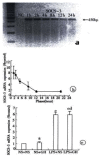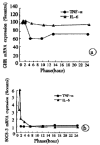The role of endotoxin, TNF-alpha, and IL-6 in inducing the state of growth hormone insensitivity
- PMID: 12046086
- PMCID: PMC4656437
- DOI: 10.3748/wjg.v8.i3.531
The role of endotoxin, TNF-alpha, and IL-6 in inducing the state of growth hormone insensitivity
Abstract
Aim: Critical illnesses such as sepsis, trauma, and burns cause a growth hormone insensitivity, which leads to an increased negative nitrogen balance. Endotoxin is generously released into blood under these conditions and stimulates the production of proinflammatory cytokines such as TNF-alpha, IL-6, and IL-1, which may play a very important role in inducing the growth hormone insensitivity. The objective of this current study was to investigate the role of endotoxin, TNF-alpha and IL-6 in inducing the growth hormone insensitivity at the receptor and post-receptor levels.
Methods: Spague-Dawley rats were injected with endotoxin, TNF-alpha, and IL-6, respectively and part of rats injected with endotoxin was treated with exogenous somatotropin simultaneously. All rats were killed at different time points. The expression of IGF-I, GHR, SOCS-3 and beta-actin mRNA in the liver was detected by RT-PCR and the GH levels were measured by radioimmunoassay, the levels of TNF-alpha and IL-6 were detected by ELISA.
Results: There was no significant difference in serous GH levels between experimental group and control rats after endotoxin injection, however, liver IGF-I mRNA expression had been obviously down-regulated in endotoxemic rats. Liver GHR mRNA expression also had a predominant down-regulation after endotoxin injection. The lowest regulation of liver IGF-I mRNA expression occurred at 12h after LPS injection, being decreased by 53% compared with control rats. For GHR mRNA expression, the lowest expression occurred at 8h and had a 81% decrease. Although SOCS-3 mRNA was weakly expressed in control rats, it was strongly up-regulated after LPS injection and had a 7.84 times increase compared with control rats. Exogenous GH could enhance IGF-I mRNA expression in control rats, but it did fail to prevent the decline in IGF-I mRNA expression in endotoxemic rats. Endotoxin stimulated the production of TNF-alpha and IL-6, and the elevated IL-6 levels was shown a positive correlation with increased SOCS-3 mRNA expression. The liver GHR mRNA expression was obviously down-regulated after TNF-alpha iv injection and had a 40% decrease at 8h, but the liver SOCS-3 mRNA expression was the 4.94 times up-regulation occurred at 40 min after IL-6 injection.
Conclusion: The growth hormone insensitivity could be induced by LPS injection, which was associated with down-regulated GHR mRNA expression at receptor level and with up-regulated SOCS-3 mRNA expression at post-receptor level. The in vivo biological activities of LPS were mediated by TNF-alpha and IL-6 indirectly, and TNF-alpha and IL-6 may exert their effects on the receptor and post-receptor levels respectively.
Figures




References
-
- Zhang JJ, Dong WF, Zhu ZY. The clinical significance and rational evaluation of early nutritional support in severe head-injured patients. World J Gastroenterol. 2000;6(Suppl3):20. - PubMed
-
- Mitch WE, Bailey JL, Wang X, Jurkovitz C, Newby D, Price SR. Evaluation of signals activating ubiquitin-proteasome proteolysis in a model of muscle wasting. Am J Physiol. 1999;276:C1132–C1138. - PubMed
Publication types
MeSH terms
Substances
LinkOut - more resources
Full Text Sources
Other Literature Sources

